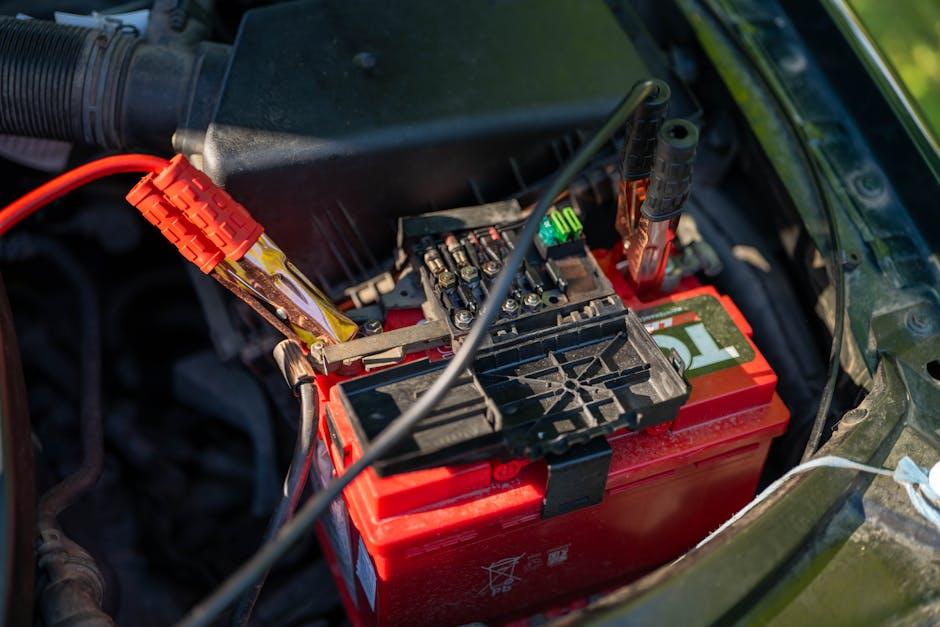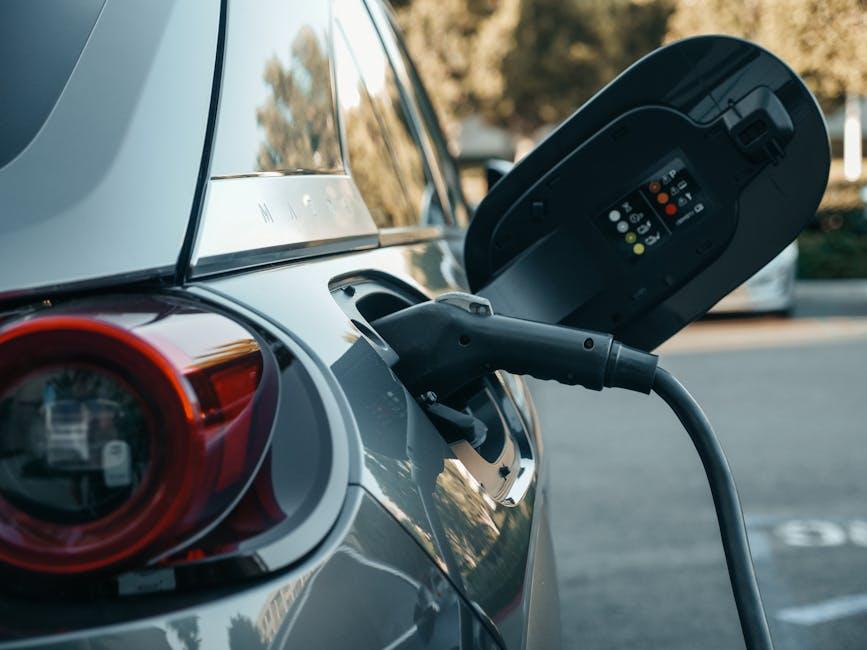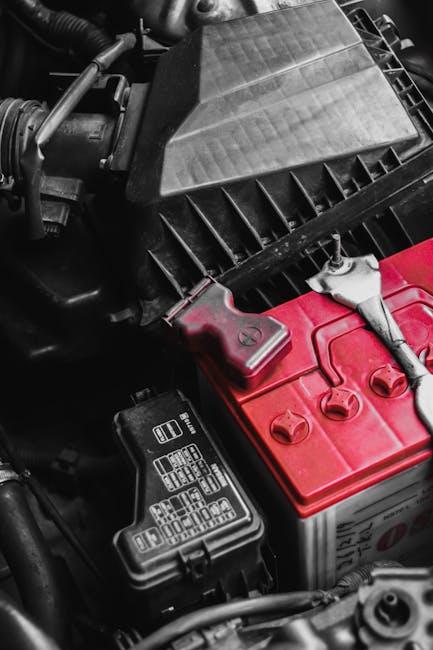Your car’s battery is the beating heart of its electrical system, powering everything from the ignition to the lights. Yet, just like any vital organ, it needs a little care to keep functioning smoothly. One of the most common yet overlooked maintenance tasks is cleaning the battery terminals. Over time, corrosion and grime can build up, creating resistance that hampers performance and may even prevent your vehicle from starting. In this article, we’ll walk you through the simple, effective steps to clean your car battery terminals—restoring the vital connection and helping your engine purr with reliable power. Whether you’re a seasoned car enthusiast or a first-time DIYer, this guide will give you the confidence to tackle this essential upkeep with ease.
Table of Contents
- Choosing the Right Tools and Safety Gear for Battery Terminal Cleaning
- Preparing Your Vehicle for Safe Access to the Battery
- Step-by-Step Guide to Removing Corrosion from Battery Terminals
- Effective Cleaning Solutions and Their Proper Usage
- Tips for Preventing Future Corrosion on Battery Connections
- Reassembling and Testing Your Battery for Optimal Performance
- Q&A
- The Way Forward

Choosing the Right Tools and Safety Gear for Battery Terminal Cleaning
Ensuring you have the proper tools and safety gear is essential for a hassle-free and effective battery terminal cleaning. Equip yourself with wire brushes designed specifically for battery terminals to scrape off corrosion without damaging the metal. A set of wrenches or pliers will be necessary for loosening and tightening terminal nuts. Don’t overlook having a small container with a mixture of baking soda and water to neutralize battery acid during cleaning. Additionally, keep some clean rags or paper towels handy to wipe off any residue after scrubbing.
Safety cannot be overstated when handling car batteries, as they contain corrosive acid and can emit hazardous gases. Always don acid-resistant gloves to protect your skin and opt for safety goggles to shield your eyes from accidental splashes. Wearing long sleeves and working in a well-ventilated area further minimizes exposure to harmful fumes. If you have access to a battery terminal protector spray, it’s beneficial for creating a barrier against future corrosion. Below is a quick reference table summarizing the must-have items:
| Tools | Safety Gear | Cleaning Supplies |
|---|---|---|
| Wire Brush | Acid-resistant Gloves | Baking Soda Solution |
| Wrenches/Pliers | Safety Goggles | Clean Rags/Paper Towels |
| Terminal Protector Spray | Long-sleeved Shirt | Well-ventilated Workspace |

Preparing Your Vehicle for Safe Access to the Battery
Before diving into the cleaning process, ensure your vehicle is parked on a flat surface and the engine is completely turned off. Safety first: disconnect the negative terminal of the battery to prevent any electrical hazards. Wearing protective gloves and goggles is highly recommended, as battery acid residues can be harmful. Additionally, having a safe workspace with adequate lighting will make the task smoother and safer.
To gain proper access to the battery, remove any covers or plastic shields that protect it. Keep track of all fasteners and parts removed to reassemble effortlessly later. If your vehicle’s battery sits in a tight or awkward space, consider consulting your owner’s manual for specific instructions to prevent damage. Organizing essential tools nearby—such as a wrench set, baking soda, water, and a wire brush—makes the entire cleaning procedure more efficient and straightforward.

Step-by-Step Guide to Removing Corrosion from Battery Terminals
Begin by ensuring the car engine is off and wear protective gloves and eyewear to keep safe from harmful substances. Start by disconnecting the negative (-) terminal first, then the positive (+). This precaution helps prevent any electrical shorts. Next, inspect the terminals and battery posts for white, ashy deposits or greenish-blue corrosion. To remove this buildup, create a simple cleaning solution by mixing baking soda with water—about a tablespoon of baking soda per cup of water works well. Dip a stiff-bristled brush or old toothbrush into the mixture and scrub the terminals and posts until the corrosion starts to loosen and come away. Be gentle to avoid damaging the terminals.
After scrubbing, use a clean, damp cloth to wipe off any remaining baking soda residue and dirt. Dry the terminals thoroughly to prevent future corrosion. Before reconnecting, apply a thin coat of petroleum jelly or a specialized battery terminal protector to repel moisture and oxidation. When you’re ready to reconnect, always attach the positive (+) terminal first, followed by the negative (-), reversing the order you used to disconnect. This careful sequence helps maintain a safe and efficient electrical connection, ensuring your battery remains in peak condition.

Effective Cleaning Solutions and Their Proper Usage
Choosing the right cleaning agent ensures the longevity of your car battery terminals while preventing potential damage. Baking soda mixed with water is a highly effective and safe solution that neutralizes the acid corrosion commonly found on terminals. Alternatively, commercial battery terminal cleaners are available, formulated specifically for automotive use. Use a small brush or an old toothbrush to gently scrub the terminals after applying the cleaning solution, making sure to avoid applying excessive force which can damage the delicate connectors.
Proper usage involves preparation and safety precautions. Always disconnect the negative terminal first to avoid short circuits. After cleaning, rinse the terminals with distilled water to remove any cleaning residue and dry them thoroughly. Applying a thin layer of petroleum jelly or battery terminal protectant spray will help prevent future corrosion. Here’s a quick reference for effective solutions and their usage:
| Cleaning Solution | Usage Tips | Benefits |
|---|---|---|
| Baking Soda + Water | Mix 1 tbsp baking soda with 1 cup water; scrub gently | Neutralizes corrosion, safe on terminals |
| Commercial Cleaner | Apply as per product instructions; use protective gloves | Fast action, designed for battery components |
| Distilled Water | Use for rinsing after cleaning | Prevents mineral residue buildup |

Tips for Preventing Future Corrosion on Battery Connections
Maintaining clean battery terminals is just the first step in extending the life of your car’s electrical system. To minimize corrosion buildup, consider applying a thin layer of petroleum jelly or dielectric grease on the battery posts and cable connectors. These act as a protective barrier, preventing moisture and air from triggering oxidation. Additionally, regularly inspecting the terminals for any signs of wear or damage allows you to catch early warning signs before they turn into stubborn corrosion problems.
Proper maintenance also involves keeping the battery area dry and free from debris. Parking your vehicle in a garage or sheltered area reduces exposure to harsh weather, which can accelerate corrosion. Below is a quick reference table to help you identify key preventive measures:
| Preventive Action | Benefit |
|---|---|
| Apply dielectric grease | Blocks moisture |
| Routine terminal inspections | Early detection of corrosion |
| Keep battery compartment clean | Prevents debris accumulation |
| Park in sheltered location | Reduces exposure to elements |

Reassembling and Testing Your Battery for Optimal Performance
Once you’ve meticulously cleaned the terminals, it’s time to reassemble your battery with care. Begin by reconnecting the positive terminal first, ensuring it’s tightened snugly to prevent any loose connections that can cause power loss or sparking. Follow this by the negative terminal, securing it firmly but without over-tightening, which could damage the battery post. Properly reassembling the battery not only guarantees a solid connection but also helps in maintaining the longevity of your vehicle’s electrical system.
After reassembly, testing the battery is crucial to confirm everything functions seamlessly. Use a multimeter or a dedicated battery tester to check the voltage and overall health. Ideally, a fully charged car battery should show a resting voltage of about 12.6 volts or higher. If the reading falls below this, consider charging your battery or investigating deeper electrical issues. Here’s a quick reference to what your battery voltage readings might mean for performance:
| Voltage Reading | Battery Condition | Recommended Action |
|---|---|---|
| 12.6V and above | Fully Charged | No action needed |
| 12.4V – 12.6V | Moderately Charged | Recharge soon |
| Below 12.4V | Discharged/Weak | Charge or replace battery |
- Ensure terminals are dry before reconnecting to avoid corrosion restart.
- Wear protective gear during testing to avoid any acid exposure.
- Retest after driving briefly to confirm the alternator is charging properly.
Q&A
Q: Why is it important to clean car battery terminals?
A: Over time, battery terminals accumulate corrosion and dirt, which can interrupt the electrical connection between the battery and the car. Cleaning the terminals ensures a strong connection, helps your car start reliably, and extends the battery’s lifespan.
Q: What signs indicate my car battery terminals need cleaning?
A: Look for a white, ashy, or bluish-green crust around the terminals. Your car might also experience difficulty starting, dim headlights, or electrical issues, all potential clues pointing to corroded terminals.
Q: What tools and materials do I need to clean battery terminals safely?
A: You’ll want a pair of protective gloves and eyewear, baking soda, water, an old toothbrush or wire brush, a wrench, and some clean rags. Baking soda neutralizes battery acid safely, making it an ideal cleaner for corrosion.
Q: How do I prepare my car before cleaning the battery terminals?
A: First, ensure your car is turned off and the keys are removed from the ignition. For safety, disconnect the negative (black) terminal first, then the positive (red) terminal. This prevents accidental short circuits during cleaning.
Q: What is the step-by-step process for cleaning car battery terminals?
A: Mix a tablespoon of baking soda with a cup of water to create a cleaning solution. Dip your brush into the mixture and scrub the terminals and cable connectors to remove corrosion. Rinse with clean water, dry thoroughly, and reconnect the terminals—positive first, then negative.
Q: Are there any precautions I should take while cleaning battery terminals?
A: Absolutely. Battery acid is corrosive, so always wear protective gloves and eyewear. Avoid sparks by keeping metal tools away from the battery top. Work in a well-ventilated area and never smoke near the battery.
Q: Can I prevent corrosion buildup on my battery terminals?
A: Yes! Apply a thin layer of petroleum jelly or a commercial terminal protectant spray to the terminals after cleaning. This barrier helps repel moisture and prevent future corrosion.
Q: How often should I clean my car battery terminals?
A: It’s good practice to inspect your battery terminals every six months, especially in extreme weather conditions. Clean them as soon as you notice any corrosion or grime buildup for optimal performance.
Q: What if cleaning doesn’t fix my car’s starting issues?
A: If the terminals are clean but problems persist, the battery might be failing or there could be other electrical issues. Consider having your battery and charging system tested by a professional to diagnose the problem.
Q: Is professional help necessary, or can I clean the terminals myself?
A: Cleaning battery terminals is a straightforward DIY task if you follow safety precautions carefully. However, if you’re uncomfortable or unsure, seeking professional assistance is always a wise choice.
The Way Forward
Keeping your car battery terminals clean is a small task that yields big benefits, ensuring a smoother start every time you turn the key. With just a bit of care and the right technique, you can prevent corrosion, improve electrical connections, and extend the life of your battery. So next time your engine hesitates to roar to life, remember—the solution might be as simple as a quick, thorough terminal cleaning. Safe travels and happy driving!

